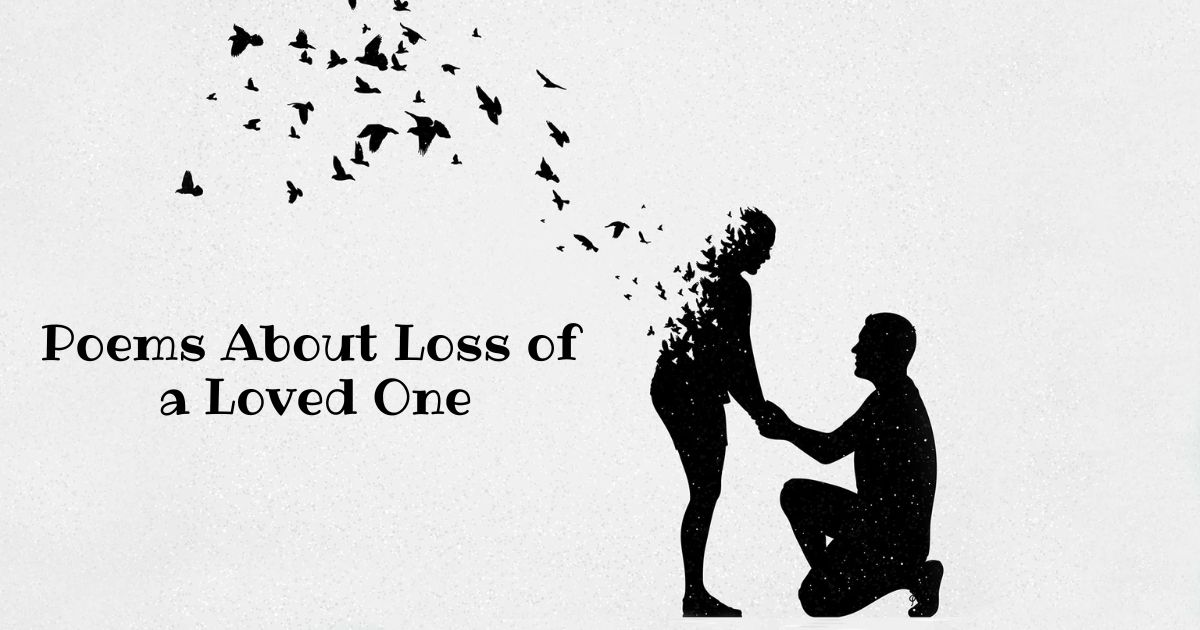Grief speaks a language that ordinary words cannot capture, yet poetry transforms our deepest sorrows into verses that heal.
When we lose someone precious, poems about loss of a loved one become bridges between heartbreak and hope.
These twenty carefully crafted verses explore every facet of mourning, offering comfort through shared human experience.
More Post: 20 Haiku for I Love You Poems
Empty Chair – A Poem About Loss of a Loved One
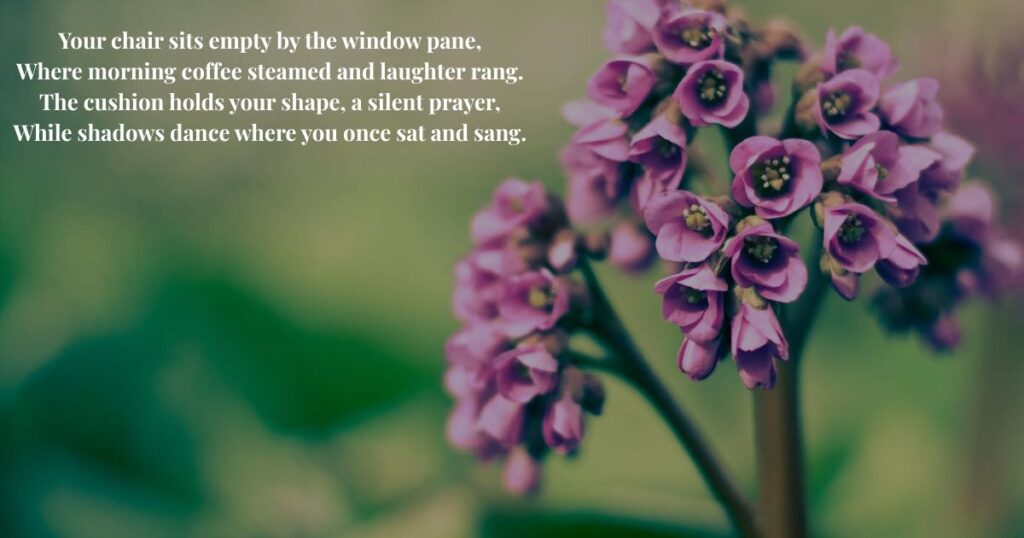
Your chair sits empty by the window pane,
Where morning coffee steamed and laughter rang.
The cushion holds your shape, a silent prayer,
While shadows dance where you once sat and sang.
I set your place each evening out of habit,
Two plates, two cups, though only one gets filled.
The empty space speaks louder than my weeping,
A hollow echo where your voice once thrilled.
Your reading glasses rest upon the table,
Beside the book you’ll never finish now.
The bookmark marks a journey left suspended,
While I sit learning grief’s relentless vow.
The physical absence of someone we cherish creates the cruelest paradox—their presence felt most acutely through their absence. This verse captures how empty spaces become monuments to memory, transforming ordinary furniture into sacred shrines that hold the weight of what once was.
Whispers in the Wind – Remembering Through Nature
The autumn leaves spiral down like your whispers,
Each golden fragment carrying your voice.
I hear you in the rustling of the branches,
In wind chimes singing your forgotten choice.
The seasons change but carry you within them,
Spring’s first bloom holds your gentle touch.
Summer thunderstorms echo your wild laughter,
While winter’s silence says so very much.
You’ve become the sunrise painting mountains,
The evening star that guides me safely home.
In every breeze, I feel your love surrounding,
Through nature’s voice, you’re never truly gone.
Nature becomes our spiritual messenger after loss, offering signs and symbols that transcend physical boundaries. Many grieving individuals report sensing their loved ones through natural phenomena—sudden breezes, unexpected wildlife encounters, or flowers blooming out of season—creating meaningful connections that provide profound comfort during the darkest moments.
Photographs Don’t Fade – When Memories Become Treasures
These frozen moments scattered on my dresser
Hold conversations we can’t have today.
Your smile preserved in fading Polaroids
Speaks volumes that fresh tears can’t wash away.
I trace your face through decades of remembrance,
From wedding day to grandchildren’s first steps.
Each photograph’s a portal to our history,
Where time stands still and death’s cruel claim forgets.
The albums tell our story without words,
Adventures shared, milestones we celebrated.
Though you’ve moved beyond these captured seconds,
In every frame, our love stays unabated.
Visual memories serve as tangible connections to departed loved ones, allowing us to revisit shared experiences and maintain emotional bonds across the divide of death. Research shows that looking at photographs of deceased loved ones activates the same brain regions associated with love and attachment, demonstrating how images literally keep relationships alive in our neural pathways.
The Last Goodbye – Unfinished Conversations
If I had known that Tuesday was our ending,
I would have lingered longer at your door.
Instead I rushed through “see you later, darling,”
Not knowing later wouldn’t come anymore.
The words I saved for some imagined future
Now weigh like stones upon my heavy chest.
“I love you” seems so small for all I’m feeling,
Yet it’s the phrase I should have said the best.
I replay our final conversation nightly,
Searching for clues I somehow failed to see.
But perhaps the greatest gift you left me
Is knowing love needs no formality.
Regret over final moments haunts many grieving hearts, creating painful scenarios of “what if” and “if only.” However, relationship experts emphasize that genuine love communicates itself through countless daily interactions, not just final words. The accumulation of shared experiences, kindnesses, and quiet moments often speaks louder than any perfectly crafted goodbye.
Midnight Tears – Grief in Solitary Moments
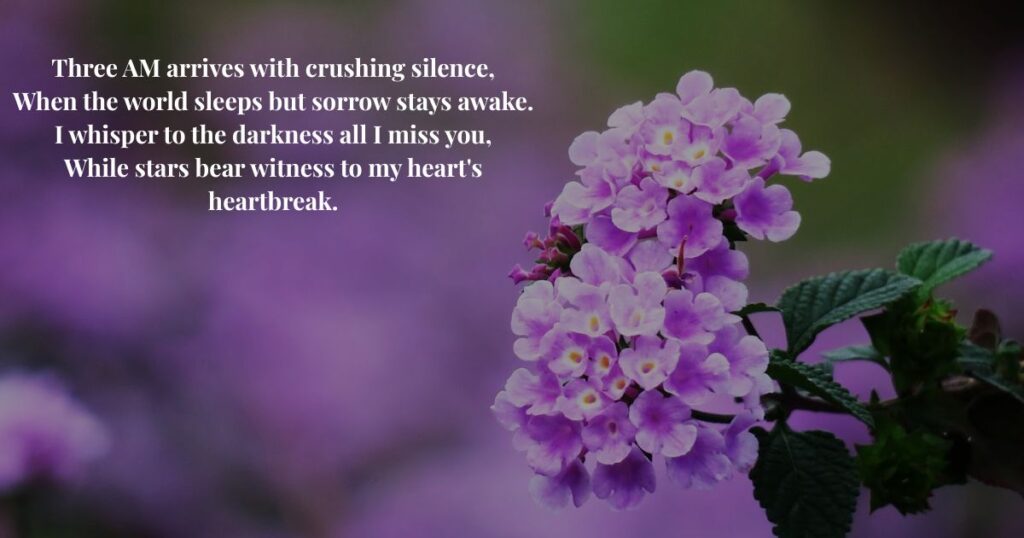
Three AM arrives with crushing silence,
When the world sleeps but sorrow stays awake.
I whisper to the darkness all I miss you,
While stars bear witness to my heart’s heartbreak.
The nights stretch endless, filled with your absence,
Each hour marking time since you departed.
Grief visits fiercely in these quiet hours,
When defenses fall and I’m most brokenhearted.
Dawn brings duties that require my presence,
Masks I wear to navigate the day.
But midnight knows my truest, rawest sorrow,
Where tears fall freely, washing pain away.
Nighttime grief intensifies emotional pain because darkness removes distractions and amplifies internal suffering. Sleep researchers note that grief disrupts natural circadian rhythms, often causing insomnia or restless sleep patterns. The solitary nature of nighttime creates space for unfiltered emotional processing, making 3 AM tears both the most painful and sometimes most healing part of the grieving journey.
Your Favorite Song – Music as Memory Keeper
The radio plays our wedding dance again,
And suddenly you’re spinning me around.
Your voice harmonizes with the melody,
Though you’ve been gone, in music you are found.
I can’t drive past that old familiar station
Without remembering you singing along.
Your off-key notes were sweeter than perfection,
Now silence echoes where you sang your song.
The playlist of our life keeps auto-playing,
Each track a chapter of our shared romance.
Though death may steal your voice from future mornings,
In every song, you’ll have another chance.
Musical memory creates powerful emotional triggers because music activates multiple brain regions simultaneously, including areas responsible for emotion, memory, and motor function. Neurologists have discovered that musical memories often remain intact longer than other types of memories, explaining why hearing a deceased loved one’s favorite song can instantly transport us back to shared moments with startling clarity and emotional intensity.
Garden of Remembrance – Growth Through Loss
I planted roses where we scattered ashes,
Each bloom a prayer, each thorn a sacred tear.
The garden grows more beautiful each season,
Fed by memories of our love so dear.
Your essence mingles with the rich, dark soil,
Nurturing life from loss’s barren ground.
In every flower’s face, I see your smile,
In rustling leaves, your gentle voice’s sound.
Death planted seeds I never knew existed,
Now strength and beauty rise where sorrow fell.
This garden proves that love survives transition,
Growing ever upward from grief’s deepest well.
Memorial gardens provide therapeutic spaces for processing grief while creating living tributes to deceased loved ones. Horticultural therapy studies demonstrate that gardening activities reduce cortisol levels and promote emotional healing. The cyclical nature of plant growth—death, dormancy, and rebirth—offers powerful metaphors for the grief journey, helping mourners understand that ending can birth new forms of beauty and meaning.
Mirror Without Reflection – Identity After Loss
I barely recognize the face that greets me,
These eyes that learned the language of goodbye.
Half of my reflection disappeared with you,
Now I must learn to be just me, not “we.”
The pronouns of my life need slow adjusting,
From “our plans” to “my uncertain days ahead.”
Identity feels foreign in this new skin,
Where “us” has died but somehow I’m not dead.
I’m excavating who I was before you,
While honoring who we became together.
This mirror shows a stranger learning courage,
To stand alone yet love you still forever.
Identity reconstruction after significant loss challenges our fundamental sense of self, particularly when relationships have been long-term or deeply intertwined. Grief counselors recognize that losing a life partner often triggers what psychologists call “identity foreclosure”—the need to rediscover individual identity separate from couple identity. This process typically takes 18-24 months and involves both mourning the lost relationship and gradually embracing newfound independence.
Birthday Wishes to Heaven – Celebrating the Absent
Today marks seventy-three years of your existence,
Though you’ve been gone for three long winters now.
I light candles for a ghost who won’t blow them out,
And sing “Happy Birthday” to an empty vow.
Your favorite cake sits untouched on the counter,
Chocolate frosting spelling out your name.
The grandkids ask why Grandpa isn’t coming,
And birthdays will never feel quite the same.
But celebration seems the truest honor,
For all the joy you brought to this small world.
So I’ll keep marking days that mattered to you,
Until my own life’s final flag’s unfurled.
Commemorating special dates helps maintain continuing bonds with deceased loved ones while gradually transforming painful reminders into meaningful rituals. Research from the Centre for Grief Studies shows that families who create new traditions around significant dates—birthdays, anniversaries, holidays—report better long-term adjustment and reduced anxiety. These celebrations acknowledge both loss and love, honoring memory while allowing grief to coexist with gratitude.
Letters Never Sent – One-Way Correspondence
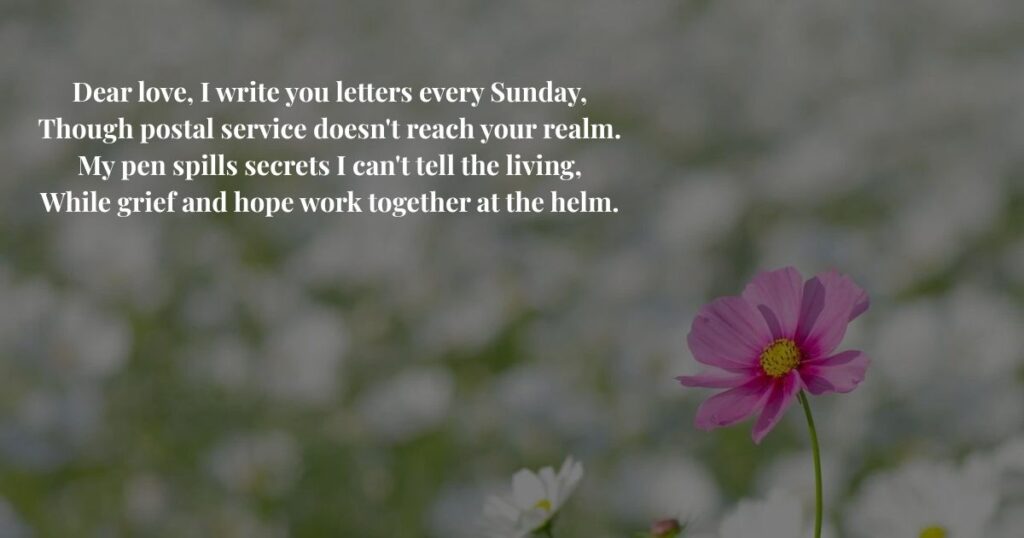
Dear love, I write you letters every Sunday,
Though postal service doesn’t reach your realm.
My pen spills secrets I can’t tell the living,
While grief and hope work together at the helm.
I tell you about children’s first achievements,
The garden’s progress through another spring.
I share my fears, my dreams, my daily struggles,
As if your reading gives my words their wings.
These letters pile up in my bedside drawer,
A one-way correspondence with the past.
But somehow writing keeps our conversation
Alive and growing, destined still to last.
Letter writing to deceased loved ones provides therapeutic benefits by maintaining emotional connection and processing complicated feelings. Narrative therapy techniques often incorporate this practice, as writing helps organize chaotic grief emotions into coherent expressions. Many hospices and grief support groups recommend continuing correspondence as a healthy way to work through unresolved issues, share ongoing life updates, and maintain the sense that love transcends physical boundaries.
Kitchen Conversations – Domestic Sacred Spaces
The kitchen holds our thousand morning talks,
Coffee-scented wisdom shared at dawn.
Your empty mug still waits beside the sink,
Though sunrise comes now that you’ve moved on.
I hear your laughter echo off the cabinets
Where we planned vacations, shared our fears.
This ordinary room became our sanctuary,
Seasoned with joy and occasional tears.
Now cooking feels like visiting a temple
Where memories simmer with each meal I make.
Your recipes live on in every dinner,
Sacred ingredients for love’s sweet sake.
Domestic spaces carry profound emotional significance after loss, often becoming informal shrines where memory and daily life intersect. Environmental psychology research indicates that familiar spaces trigger powerful emotional responses because they contain layered associations built over time. Kitchens particularly serve as family gathering centers, making them especially potent locations for grief processing and memory preservation in the midst of necessary daily routines.
Winter’s Embrace – Seasonal Grief Patterns
December brought you peace at last, my darling,
While snow fell soft upon your final sleep.
Now every winter carries double meaning:
Nature’s rest and memories I keep.
The cold reminds me of your failing warmth,
Those final days when blankets couldn’t help.
Yet somehow winter’s beauty speaks your language,
Pristine and pure, beyond mere mortal help.
Spring will return as it always has before,
But I’ll remember winter held you last.
In crystalline moments, frozen and perfect,
Your love persists beyond time’s steady past.
Seasonal grief patterns affect mourning intensity, with many bereaved individuals experiencing heightened emotions during specific seasons or weather conditions. Mental health professionals recognize Seasonal Affective Disorder (SAD) as a complicating factor in grief, particularly when death occurs during darker months. Understanding these patterns helps normalize the cyclical nature of grief and encourages seasonal self-care strategies to navigate difficult anniversaries and environmental triggers.
Dreams of Reunion – Sleep as Sanctuary
You visit me in dreams almost nightly,
Young again and free from earthly pain.
We dance through landscapes made of pure remembrance,
Where death’s cruel rules simply don’t pertain.
I wake up reaching for your phantom presence,
The pillow cold where dream-you held me tight.
These sleeping reunions feel more real than daylight,
Brief respites in grief’s relentless fight.
I treasure every dream-delivered message,
Each subconscious meeting with your soul.
Though morning steals you from my sleeping arms,
Night promises to make my heart feel whole.
Dream visitations from deceased loved ones occur in approximately 60% of bereaved individuals, according to sleep and bereavement studies. These experiences often provide comfort and closure, with many reporting that departed loved ones appear healthy, peaceful, and free from suffering. While science explains these dreams as the brain’s way of processing loss and maintaining attachment bonds, their therapeutic value remains profound regardless of their source or meaning.
Their Favorite Flower – Symbolic Remembrance
Sunflowers bloom beside your headstone now,
Golden faces turning toward the light.
You always said they looked like pure sunshine,
Making even cloudy days seem bright.
I plant them every spring in your remembrance,
Watch them grow from tiny seeds to towers.
Their bold, bright faces mirror your persistence,
Finding joy in life’s most trying hours.
When autumn comes and flowers face their ending,
I gather seeds for next year’s hopeful crop.
Like love itself, they’ll rise again come springtime,
A cycle beautiful that will not stop.
Symbolic objects create tangible connections to deceased loved ones, serving as physical reminders of personality traits, shared experiences, or meaningful characteristics. Grief therapists often encourage clients to identify and interact with such symbols as part of healthy mourning processes. These objects—flowers, jewelry, books, music—become vessels for carrying love forward while providing comfort during difficult moments.
The Clothes They Wore – Tangible Connections
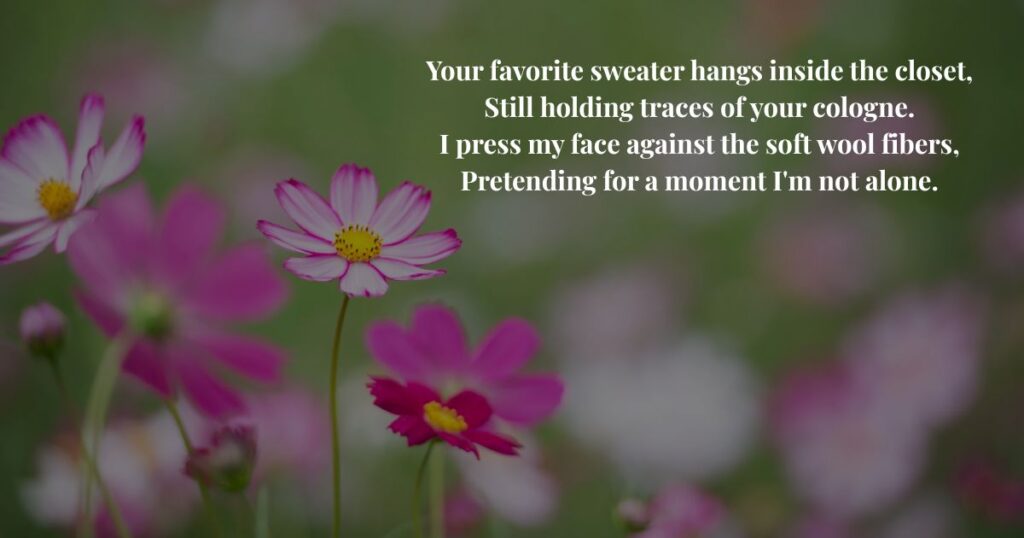
Your favorite sweater hangs inside the closet,
Still holding traces of your cologne.
I press my face against the soft wool fibers,
Pretending for a moment I’m not alone.
Each piece of clothing tells a different story:
The tie you wore to our daughter’s wedding day,
Work shirts that carried you through forty years,
Pajamas where you spent your final stay.
I can’t decide what to keep and what to give,
Each garment holds a piece of who you were.
So for now, they’ll stay exactly as you left them,
My textile museum, memories that endure.
Personal belongings carry emotional significance because they retain physical traces—scent, texture, familiar shapes—that trigger powerful sensory memories. Grief counselors recommend taking time with belongings decisions, as rushing this process can interrupt natural mourning patterns. Many find comfort in keeping select items while donating others to meaningful causes, creating balance between preservation and release.
Lessons They Taught Me – Living Legacy
You taught me how to fold fitted sheets properly,
Make gravy without lumps, and forgive quickly.
Your wisdom echoes in my daily choices,
A voice that guides me still, softly, thickly.
“Kill them with kindness,” you would always say
When faced with difficult people or situations.
I hear your counsel in my moments of anger,
Your gentle strength in life’s complications.
The lessons live on long after the teacher,
Planted deep in soil you’ll never see bloom.
But I’m your greatest work still in progress,
Carrying light you shared beyond the tomb.
Inherited wisdom represents one of grief’s most healing aspects—the recognition that relationships continue influencing us long after physical separation. Psychologists studying “continuing bonds” theory have found that maintaining connection through learned values, inherited skills, and remembered advice supports healthy grief adjustment. These living legacies transform loss into ongoing relationship, where love expressed through behavior keeps bonds strong and meaningful.
If Heaven Has a Phone – Impossible Communications
If heaven has a phone, I’d call you daily
To share the news you’re missing here below.
I’d tell you about grandkids’ latest triumphs,
All the silly things I think you’d want to know.
I’d ask if you’re at peace and free from worry,
If you can see us stumbling through without you.
Most importantly, I’d say “I love you, always,”
Words that death could never steal or doubt through.
But silence is the only answer given
To prayers that rise like incense to the sky.
Yet somehow love transcends all human technology,
Speaking heart to heart beyond goodbye.
Communication longing represents a universal aspect of grief—the desperate desire for one more conversation, one final exchange of thoughts and feelings. This yearning often manifests in prayer, meditation, or talking aloud to the deceased. While no supernatural phone line exists, many find comfort in creating rituals that simulate communication, whether through journal writing, visiting graves, or simply speaking to photographs as they go about daily life.
Anniversary of Silence – Marking Difficult Dates
Three years ago today, your heart stopped beating,
The day that split my life in two distinct parts.
Before and after mark my new chronology,
Measured by the absence in my heart.
This date returns each year with cruel precision,
Circled red upon my calendar of grief.
While others see just Tuesday, March the fifteenth,
I see the boundary of my disbelief.
But anniversaries can teach us something:
That time moves forward even through our pain.
Three years of breathing without you beside me
Proves love survives what death tried to drain.
Death anniversaries create annual grief cycles that many bereaved individuals find particularly challenging. Mental health professionals recognize these dates as predictable stress points requiring special attention and self-care planning. Some find comfort in creating meaningful rituals—visiting special places, lighting candles, sharing memories with family—while others prefer quiet reflection. Understanding that anniversary reactions are normal helps validate the ongoing nature of grief and the importance of honoring these significant dates.
Their Hands in Mine – Physical Memory Poetry
I memorized the map of your dear hands,
Each line and freckle, every callused spot.
Your fingers interlaced with mine for decades,
A perfect fit that time could not forgot.
I miss your touch more than your voice or laughter,
The gentle way you’d stroke away my fears.
Your hands that held our babies, built our home,
Wiped countless hurts and dried so many tears.
Now my hands reach out to empty air,
Searching for your warmth in cold bedsheets.
But muscle memory holds what death released:
The phantom touch that makes me feel complete.
Physical memory creates some of grief’s most poignant aspects because touch involves complex neurological pathways that store sensory experiences long after physical contact ends. Research in somatic psychology shows that bereaved individuals often experience “phantom touch”—sensing the physical presence of deceased loved ones. These sensations, while sometimes unsettling, represent normal grief responses and often provide comfort during the most lonely moments of mourning.
Love Doesn’t Die – Eternal Connection Affirmation
They say that love is stronger than the grave,
And now I know those words ring deeply true.
Though death has claimed your body from this world,
My heart still beats in rhythm with your due.
The connection forged through years of shared existence
Cannot be severed by mortality’s cruel hand.
You live within each kindness that I offer,
Each moment when I choose to understand.
So death, you’ve won a battle, not the war,
For love transcends the boundaries you create.
In every breath, I carry you forward,
Eternal bond that time cannot abate.
Continuing bonds research has revolutionized grief understanding, moving away from “letting go” models toward recognizing that healthy mourning involves maintaining ongoing emotional connections with deceased loved ones. This final poem celebrates the triumph of love over death’s temporary victory, acknowledging that while physical presence ends, emotional bonds, learned behaviors, and internalized relationships continue indefinitely, transforming but never truly ending.
More Post: 20 Funeral Praise and Worship Songs
Conclusion
Poetry transforms grief’s raw chaos into healing verses that honor both pain and love simultaneously.
These poems about loss of a loved one remind us that mourning is not a problem to solve but a sacred journey to walk with courage and compassion.
Through shared words and universal emotions, we discover that love indeed transcends death, living on in every heart that dares to remember and cherish what was, what is, and what always will be.

Lyric lover, word weaver, and music soul behind Casualspeaking.Com. I decode emotions into verses, one line at a time. Join me where rhythm meets meaning, and lyrics speak louder.
